Spatiotemporal Evolution and Mechanisms of Polder Land Use in the “Water-Polder-Village” System: A Case Study of Gaochun District in Nanjing, China
Abstract
:1. Introduction
2. Materials and Methods
2.1. Study Area
2.2. Data
2.3. Methodology
2.3.1. Index
Land-Use Transfer Flow
Degree of Land Use
Dominant Change Index
2.3.2. Factors
2.3.3. Model
3. Spatiotemporal Evolutions
3.1. Land Use
3.2. Land-Use Transfer and Indices
3.3. Spatial Change in Land Use
4. Model Results
4.1. Model Parameters
4.2. Mechanisms
4.2.1. Natural and Ecological Factors
4.2.2. Development and Construction Factors
4.2.3. Population and Economic Factors
5. Discussion
5.1. Change in Land Use
5.2. Mechanisms of Change
6. Conclusions
Author Contributions
Funding
Data Availability Statement
Acknowledgments
Conflicts of Interest
Appendix A
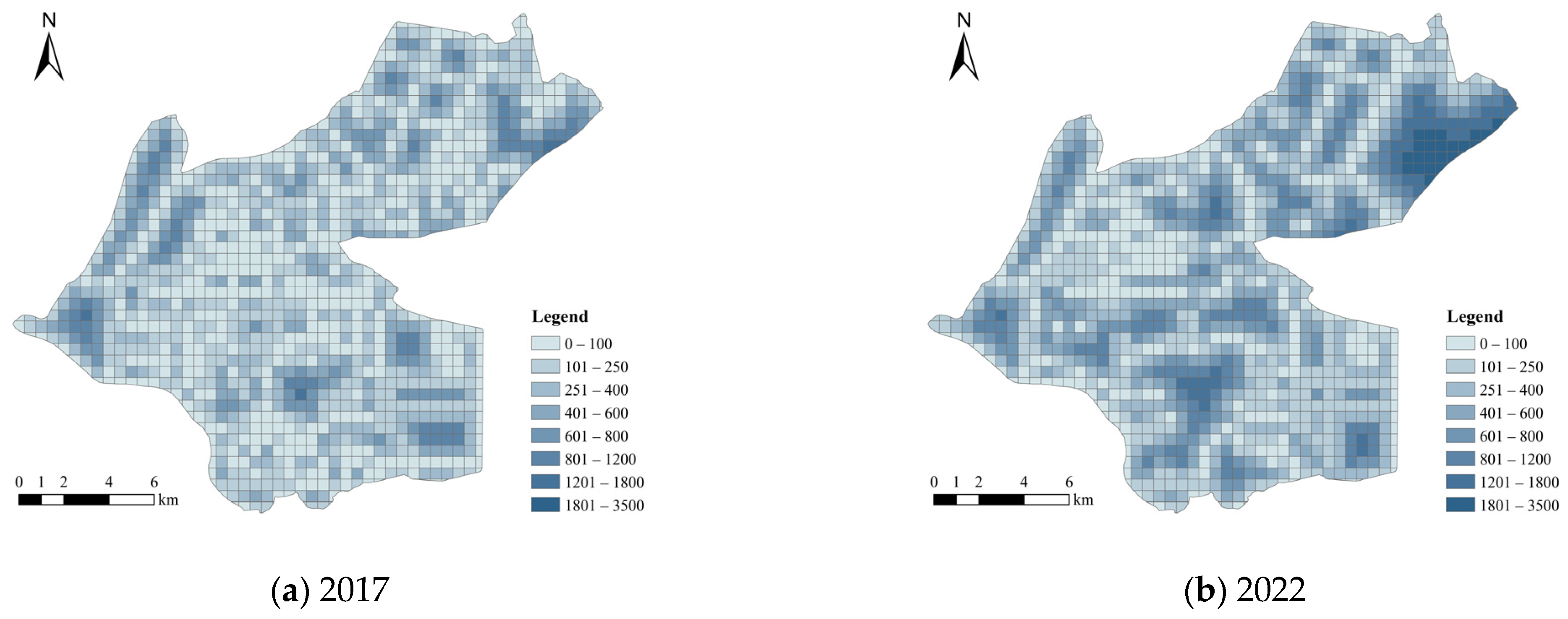





| Variables | Model 1: 2017 | Model 2: 2022 | ||
|---|---|---|---|---|
| Coefficient | VIF | Coefficient | VIF | |
| X1 | 0.279 *** | 1.05 | 0.177 *** | 1.26 |
| X2 | −0.389 *** | 1.19 | −0.475 *** | 1.39 |
| X3 | 0.064 ** | 1.15 | 0.180 *** | 1.09 |
| X4 | −0.064 ** | 1.25 | −0.104 *** | 1.23 |
| X5 | −0.150 *** | 2.11 | −0.098 *** | 2.15 |
| X6 | −0.043 | 1.96 | −0.072 ** | 1.99 |
| 1 | Local gazetteers are comprehensive records of China’s local history, compiled by officials and local gentry, containing detailed information about landscapes, culture, and notable figures. |
| 2 | https://scihub.copernicus.eu/ (accessed on 26 October 2022). |
| 3 | https://www.openstreetmap.org (accessed on 5 January 2023). |
| 4 | https://www.earthdata.nasa.gov/ (accessed on 29 December 2022). |
| 5 | https://www.worldpop.org/ (accessed on 5 January 2023). |
| 6 | https://lbs.amap.com/ (accessed on 9 January 2023). |
References
- Li, Y.; Ye, Y.; Zhang, C.; Li, J.; Fang, X. A spatially explicit reconstruction of cropland based on expansion of polders in the Dongting Plain in China during 1750–1985. Reg. Environ. Chang. 2019, 19, 2507–2519. [Google Scholar] [CrossRef]
- Segeren, W.A. Introduction to polders of the world. Water Int. 1983, 8, 51–54. [Google Scholar] [CrossRef]
- Wang, J.; Gao, M.; Guo, H.; Chen, E. Spatiotemporal distribution and historical evolution of polders in the Dongting Lake area. China. J. Geogr. Sci. 2016, 26, 1561–1578. [Google Scholar] [CrossRef]
- Qiu, M.; Dai, D. Inheritance and development of traditional eco-wisdom of polder landscape in Yangtze River Region based on landscape regeneration. Chin. Landsc. Archit. 2019, 35, 94–98. [Google Scholar]
- Ji, F.; Zhang, X.; Ding, R.; Zheng, W. Planning strategy and practice of polder blue-green space in the lower reaches of the Shuiyang River. Planners 2023, 39, 139–144. [Google Scholar]
- Wang, J.; Tang, C.; Yan, W. Mechanism and pattern of polders in the Yangtze River Delta: Effective physical form for ecosystem services provision. Landsc. Archit. 2018, 1, 38–44. [Google Scholar] [CrossRef]
- Guo, W.; Hou, X. From land consolidation to comprehensive planning summary and implications of the evolution of rural landscape renovation in The Netherlands. Landsc. Archit. 2016, 9, 115–120. [Google Scholar]
- Li, Z.; Lu, X.; Han, X.; Wang, L.; Tang, X.; Lin, X. Quantitative morphology of polder landscape based on SOM identification model: Case study of typical polders in the south of Yangtze River. Comput. Intel. Neurosci. 2022, 2022, 1362272. [Google Scholar] [CrossRef]
- Li, Y.; Ye, Y.; Li, J.; Zhang, C.; Fang, X. Reconstructing the spatiotemporal distribution of polders in modern Dongting Plain, Hunan Province. Appl. Geogr. 2020, 123, 102250. [Google Scholar] [CrossRef]
- Xie, Y.; Ying, J.; Chen, L. Typology, morphogenesis and adaptive transformation of Polder landscape in the Yangtze River Delta. Urb. Dev. Stud. 2022, 29, 70–77. [Google Scholar]
- Nijhuis, S.; Bing, H. Polderscapes: The landscape architecture of the Dutch Lowlands. Landsc. Archit. 2016, 8, 38–57. [Google Scholar] [CrossRef]
- Sun, J.; Zhang, L. Analysis on traditional polder landscape of Jiangnan area: A case study of Furongwei polder. Agric. Hist. China 2022, 41, 55–65. [Google Scholar]
- Adnan, M.S.G.; Abdullah, A.M.; Dewan, A.; Hall, J.W. The effects of changing land use and flood hazard on poverty in coastal Bangladesh. Land Use Policy 2020, 99, 104868. [Google Scholar] [CrossRef]
- Gao, Y.; Yuan, Y.; Wang, H.; Zhang, Z.; Ye, L. Analysis of impacts of polders on flood processes in Qinhuai River Basin, China, using the HEC-RAS model. Water Supp. 2018, 18, 1852–1860. [Google Scholar] [CrossRef]
- Laks, I.; Walczak, Z. Efficiency of polder modernization for flood protection. case study of golina polder (Poland). Sustainability 2020, 12, 8056. [Google Scholar] [CrossRef]
- Dewan, C.; Mukherji, A.; Buisson, M.-C. Evolution of water management in coastal Bangladesh: From temporary earthen embankments to depoliticized community-managed polders. Water Int. 2015, 40, 401–416. [Google Scholar] [CrossRef]
- Yan, R.; Li, L.; Gao, J. Modelling the regulation effects of lowland polder with pumping station on hydrological processes and phosphorus loads. Sci. Total Environ. 2020, 637, 200–207. [Google Scholar] [CrossRef]
- Wang, Y.W.; Pendlebury, J.; Nolf, C. The water heritage of China: The polders of Tai Lake Basin as continuing landscape. Plan. Perspect. 2022, 117315. [Google Scholar] [CrossRef]
- Tang, B.; Zhan, X.; Zhang, J. The agricultural heritage value of the polder system in Gaochun, Nanjing. Built Herit. 2019, 3, 47–58. [Google Scholar] [CrossRef]
- Fei, H.T. Peasant. Life in China: A Field Study of Country Life in the Yangtze Valley; Routledge: London, UK, 1939. [Google Scholar]
- Guo, W.; Hou, X. Dike, Reclamation and settlement: Landscape architectural analysis of polder landscape in Xiaoshao region. Chin. Landsc. Archit. 2016, 32, 41–48. [Google Scholar]
- Zhuang, H.; Man, C. The construction and management of Weitian along the Yangtze River region within Anhui Province. J. Grad. School Chin. Acad. Soc. Sci. 2013, 6, 120–124. [Google Scholar]
- Hooimeijer, F.L. The Tradition of Making: Polder Cities; Delft University of Technology: Delft, The Netherlands, 2011. [Google Scholar]
- Spoormans, L.; Navas-Carrillo, D.; Zijlstra, H.; Pérez-Cano, T. Planning history of a Dutch new town: Analysing Lelystad through its residential neighbourhoods. Urb. Plan. 2019, 4, 102–116. [Google Scholar] [CrossRef]
- Missiaen, T.; Jongepier, I.; Heirman, K.; Soens, T.; Gelorini, V.; Verniers, J.; Verhegge, J.; Crombe, P. Holocene landscape evolution of an estuarine wetland in relation to its human occupation and exploitation: Waasland Scheldt polders, northern Belgium. Neth. J. Geosci. 2017, 96, 35–62. [Google Scholar] [CrossRef]
- Wei, X.; Ye, Y.; Zhang, Q.; Li, B.; Wei, Z. Reconstruction of cropland change in North China Plain Area over the past 300 years. Glob. Planet. Change 2019, 176, 60–70. [Google Scholar] [CrossRef]
- Long, Y.; Jin, X.; Yang, X.; Zhou, Y. Reconstruction of historical arable land use patterns using constrained cellular automata: A case study of Jiangsu, China. Appl. Geogr. 2014, 52, 67–77. [Google Scholar] [CrossRef]
- Li, Z.; Lu, X.; Shi, J.; Huang, R.; Gao, Y. Quantitative research of landscape texture for polders in Xuanwu Plain based on morphological index: A case study of Yongfeng Polder, Gucheng Lake. Chin. Landsc. Archit. 2023, 39, 41–46. [Google Scholar] [CrossRef]
- Paradis, E. Probabilistic unsupervised classification for large-scale analysis of spectral imaging data. Int. J. Appl. Earth Observ. Geoinf. 2022, 107, 102675. [Google Scholar] [CrossRef]
- Phiri, D.; Simwanda, M.; Salekin, S.; Nyirenda, V.R.; Murayama, Y.; Ranagalage, M. Sentinel-2 data for land cover/use mapping: A review. Remote Sens. 2020, 12, 2291. [Google Scholar] [CrossRef]
- Rana, V.K.; Venkata Suryanarayana, T.M. Performance evaluation of MLE, RF and SVM classification algorithms for watershed scale land use/land cover mapping using sentinel 2 bands. Remote Sens. Appl. Soc. Environ. 2020, 19, 100351. [Google Scholar] [CrossRef]
- Alves, A.; Marcelino, F.; Gomes, E.; Rocha, J.; Caetano, M. Spatiotemporal land-use dynamics in continental Portugal 1995–2018. Sustainability 2020, 14, 14450. [Google Scholar] [CrossRef]
- Uddin, M.P.; Al Mamun, M.; Hossain, M.A. PCA-based feature reduction for hyperspectral remote sensing image classification. IETE Technol. Rev. 2021, 38, 377–396. [Google Scholar] [CrossRef]
- Peña Zamalloa, G.R. Spatial classification of urban land by speculative land value and MSI satellite imagery using K-means, in Huancayo, Peru. Urbano 2021, 24, 70–83. [Google Scholar] [CrossRef]
- Liu, J.; Wang, J.; Wang, S.; Wang, J.; Deng, G. Analysis and simulation of the spatiotemporal evolution pattern of tourism lands at the Natural World Heritage Site Jiuzhaigou, China. Hab Int. 2018, 79, 74–88. [Google Scholar] [CrossRef]
- Qin, F.; Fukamachi, K.; Shibata, S. Land-use/landscape pattern changes and related environmental driving forces in a Dong ethnic minority village in Southwestern China. Land 2022, 11, 349. [Google Scholar] [CrossRef]
- Zhang, Q.; Luo, G.; Li, L.; Zhang, M.; Lv, N.; Wang, X. An analysis of oasis evolution based on land use and land cover change: A case study in the Sangong River Basin on the northern slope of the Tianshan Mountains. J. Geogr. Sci. 2017, 27, 223–239. [Google Scholar] [CrossRef]
- Simwanda, M.; Murayama, Y. Spatiotemporal patterns of urban land use change in the rapidly growing city of Lusaka, Zambia: Implications for sustainable urban development. Sustain. Cities Soc. 2018, 39, 262–274. [Google Scholar] [CrossRef]
- Tian, G.; Qiao, Z.; Gao, X. Rural settlement land dynamic modes and policy implications in Beijing metropolitan region, China. Hab Int. 2014, 44, 237–246. [Google Scholar] [CrossRef]
- Yang, S.; Hu, S.; Wang, S.; Zou, L. Effects of rapid urban land expansion on the spatial direction of residential land prices: Evidence from Wuhan, China. Hab Int. 2020, 101, 102186. [Google Scholar] [CrossRef]
- Pan, Y.; Chen, S.; Niu, S.; Ma, Y.; Tang, K. Investigating the impacts of built environment on traffic states incorporating spatial heterogeneity. J. Transp. Geogr. 2019, 83, 102663. [Google Scholar] [CrossRef]
- Zhao, R.; Zhan, L.; Yao, M.; Yang, L. A geographically weighted regression model augmented by Geodetector analysis and principal component analysis for the spatial distribution of PM2. 5. Sustain. Cities Soc. 2020, 56, 102106. [Google Scholar] [CrossRef]
- Huang, Z.; Chen, R.; Xu, D.; Zhou, W. Spatial and hedonic analysis of housing prices in Shanghai. Hab Int. 2017, 67, 69–78. [Google Scholar] [CrossRef]
- Pan, Y.; Chen, S.; Li, T.; Niu, S.; Tang, K. Exploring spatial variation of the bus stop influence zone with multi-source data: A case study in Zhenjiang, China. J. Transp. Geogr. 2019, 76, 166–177. [Google Scholar] [CrossRef]
- Zhang, W.; Wang, M.Y. Spatial-temporal characteristics and determinants of land urbanization quality in China: Evidence from 285 prefecture-level cities. Sustain. Cities Soc. 2018, 38, 70–79. [Google Scholar] [CrossRef]
- Li, L.; Wang, L.; Qi, Z. The spatiotemporal variation of farmland use transition and its critical influential factors in coordinated urban-rural regions: A case of Chongqing in western China. Sustain. Cities Soc. 2021, 70, 102921. [Google Scholar] [CrossRef]
- An, X.; Jin, W.; Zhang, H.; Liu, Y.; Zhang, M. Analysis of long-term wetland variations in China using land use/land cover dataset derived from landsat images. Ecol. Indic. 2022, 145, 109689. [Google Scholar] [CrossRef]
- Li, H.; Song, W. Evolution of rural settlements in the Tongzhou District of Beijing under the new-type urbanization policies. Habitat. Int. 2020, 101, 102198. [Google Scholar] [CrossRef]
- Song, S.; Wang, S.; Ye, H.; Guan, Y. Exploratory analysis on the spatial distribution and influencing factors of Beitang landscape in the Shangzhuang Basin. Land 2022, 11, 418. [Google Scholar] [CrossRef]
- Wei, H.; Lu, C.; Liu, Y. Farmland changes and their ecological impact in the Huangshui River Basin. Land 2021, 10, 1082. [Google Scholar] [CrossRef]
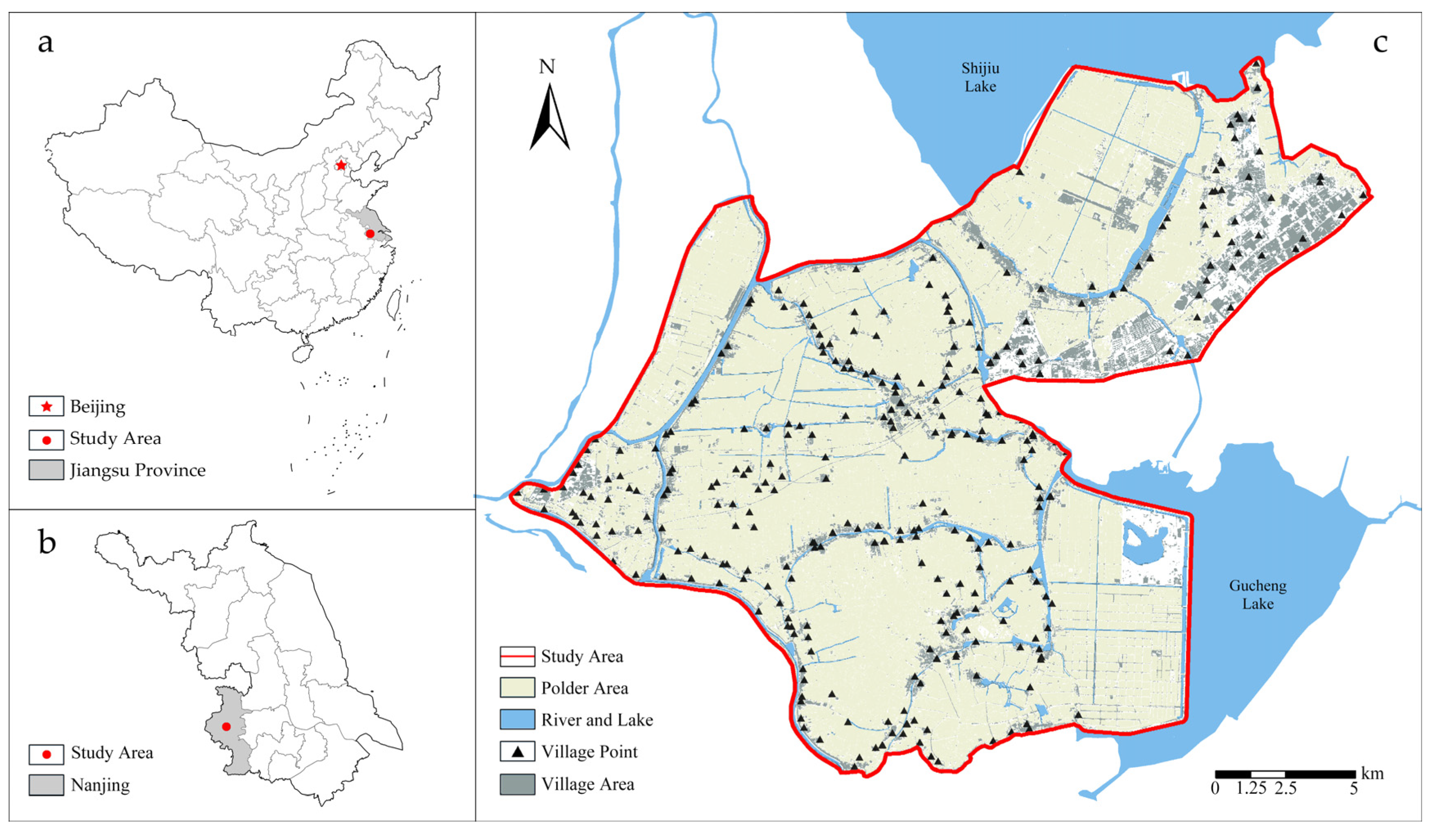
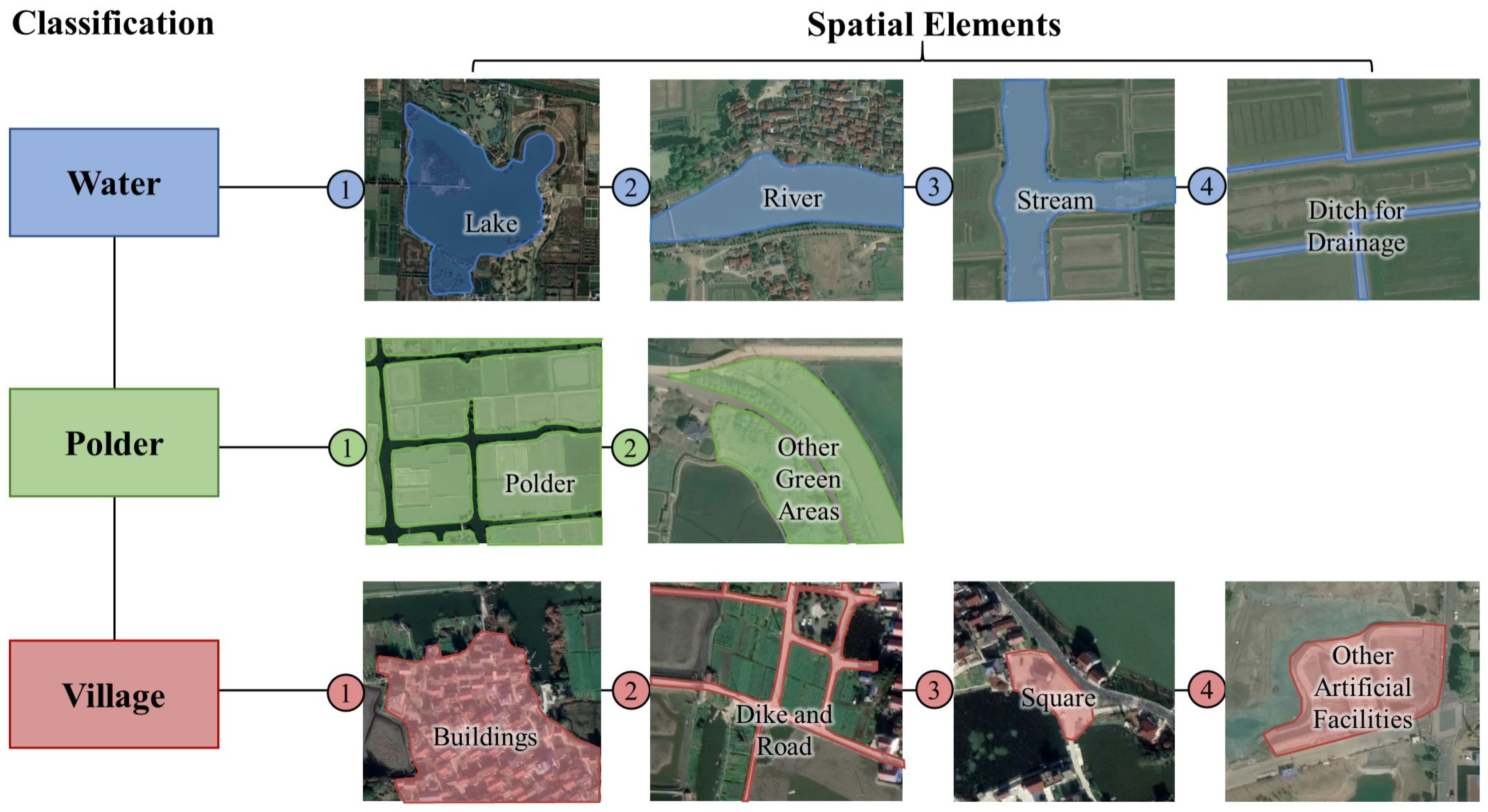
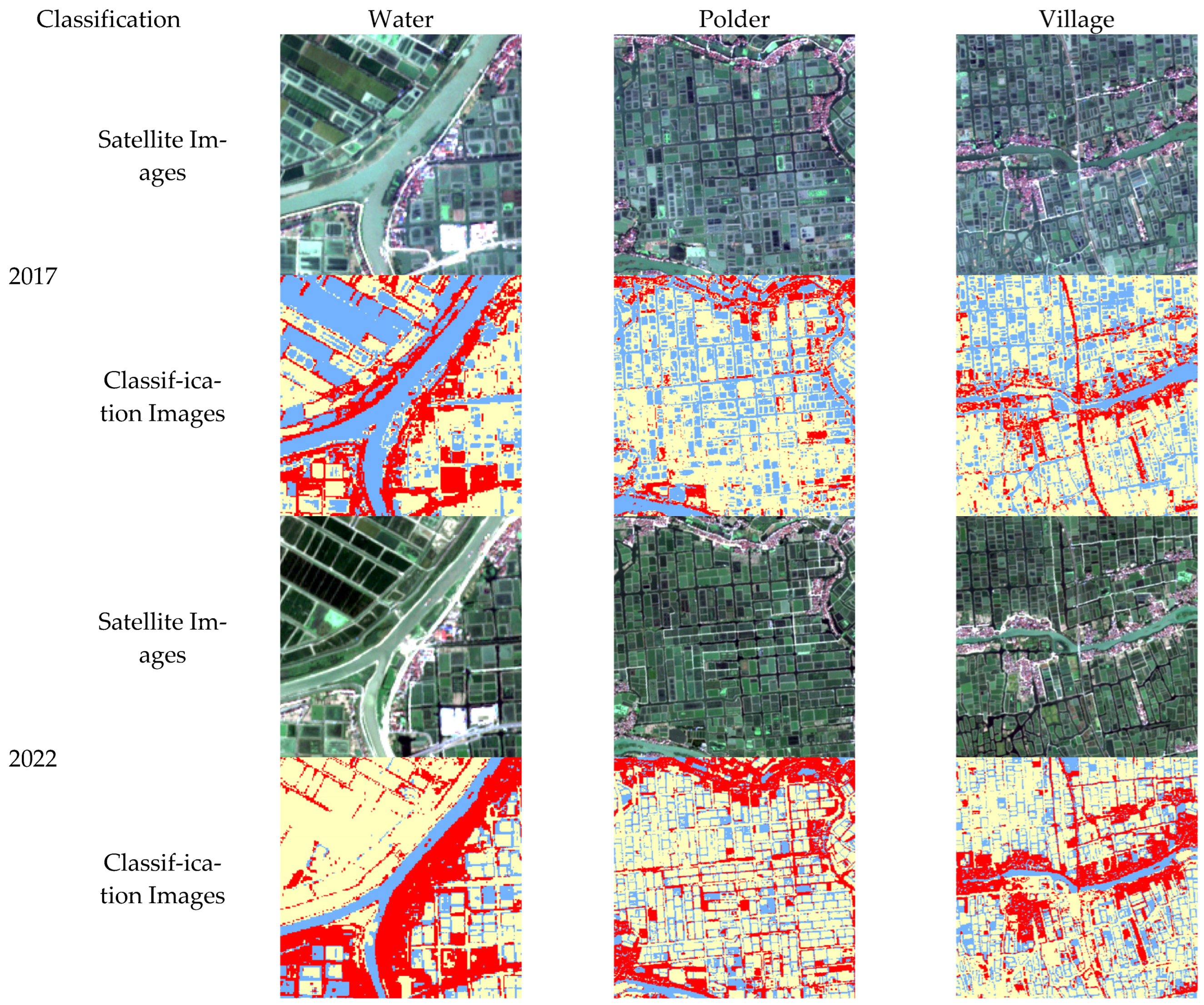


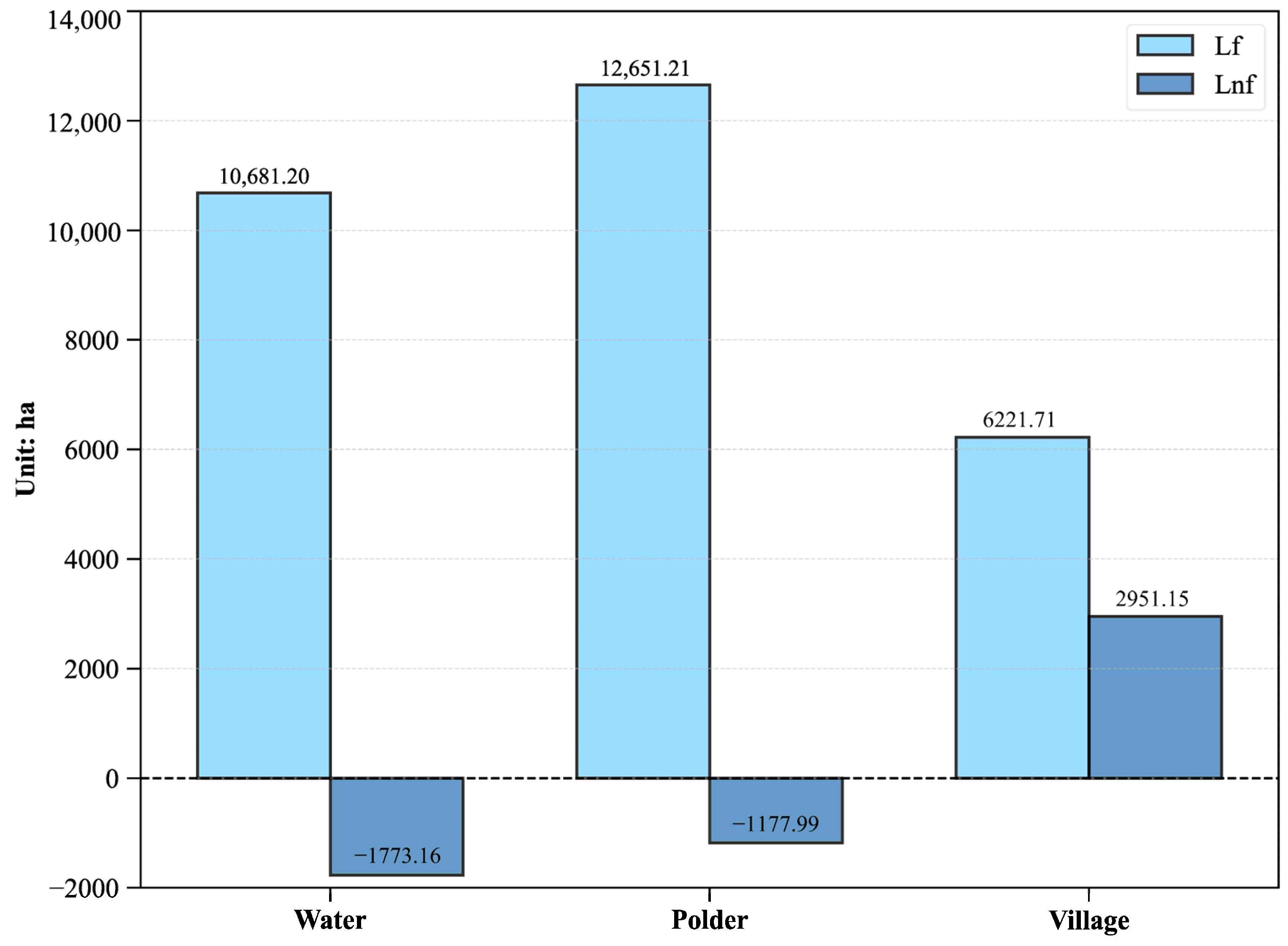
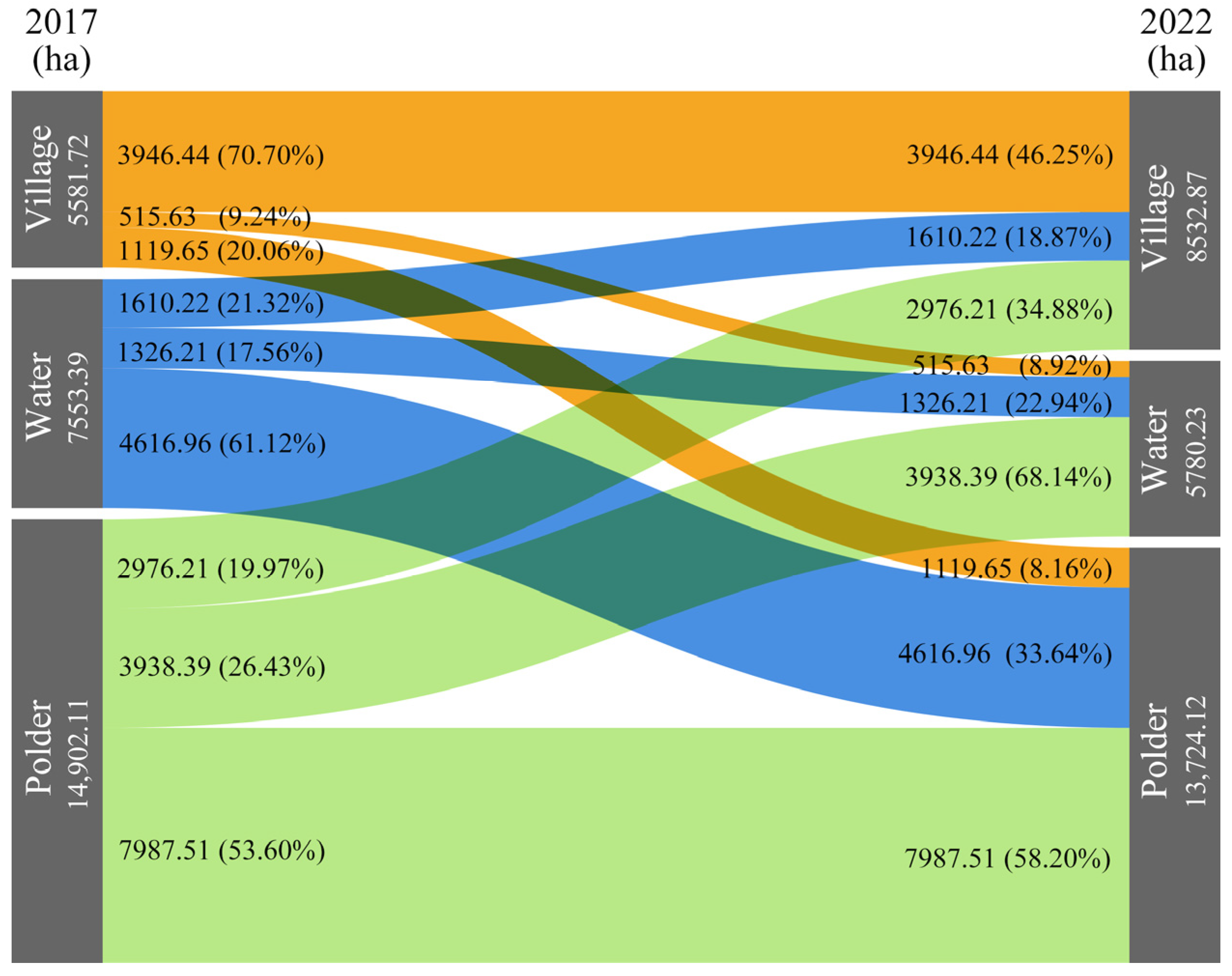







| Category | Variable Name | Abbreviation | Description |
|---|---|---|---|
| Polder | Proportion of polder | Y/PP | Proportion of polder in each grid |
| Natural and ecological factors | Distance to water | X1/DW | The Euclidean distance to water spaces (meter) |
| Elevation | X2/DEM | Mean elevation of each grid | |
| Development and construction factors | Distance to road | X3/DR | The Euclidean distance to roads (meter) |
| Village density | X4/VD | The density of village POI | |
| Population and economic factors | Population density | X5/PD | Mean population density of each grid |
| Catering density | X6/SD | The density of catering POI |
| Year | Water | Polder | Village | Total |
|---|---|---|---|---|
| 2017 | 7553.39 (26.94%) | 14,902.11 (53.15%) | 5581.72 (19.91%) | 28,037.22 (100%) |
| 2022 | 5780.22 (20.62%) | 13,724.12 (48.95%) | 8532.87 (30.43%) |
| Land-Use Type | La | |
|---|---|---|
| Water | 28.28% | 16.60% |
| Polder | 16.98% | 9.31% |
| Village | 22.29% | 47.43% |
| Variables | Moran’s I | z-Score | p-Value |
|---|---|---|---|
| X1 (17) | 0.601 | 29.106 | 0.000 |
| X1 (22) | 0.836 | 40.518 | 0.000 |
| X2 | 0.837 | 40.635 | 0.000 |
| X3 (17) | 0.824 | 40.005 | 0.000 |
| X3 (22) | 0.853 | 41.593 | 0.000 |
| X4 | 0.978 | 47.265 | 0.000 |
| X5 | 0.871 | 42.431 | 0.000 |
| X6 | 0.845 | 42.153 | 0.000 |
| OLS | GWR | |||
|---|---|---|---|---|
| 2017 | 2022 | 2017 | 2022 | |
| Model 1 | Model 2 | Model 3 | Model 4 | |
| R2 | 0.323 | 0.365 | 0.614 | 0.586 |
| AICC | 3058.07 | 2978.38 | 2500.58 | 2585.82 |
Disclaimer/Publisher’s Note: The statements, opinions and data contained in all publications are solely those of the individual author(s) and contributor(s) and not of MDPI and/or the editor(s). MDPI and/or the editor(s) disclaim responsibility for any injury to people or property resulting from any ideas, methods, instructions or products referred to in the content. |
© 2023 by the authors. Licensee MDPI, Basel, Switzerland. This article is an open access article distributed under the terms and conditions of the Creative Commons Attribution (CC BY) license (https://creativecommons.org/licenses/by/4.0/).
Share and Cite
Zhou, W.; Zhang, Y.; Tang, Y. Spatiotemporal Evolution and Mechanisms of Polder Land Use in the “Water-Polder-Village” System: A Case Study of Gaochun District in Nanjing, China. Land 2023, 12, 1714. https://doi.org/10.3390/land12091714
Zhou W, Zhang Y, Tang Y. Spatiotemporal Evolution and Mechanisms of Polder Land Use in the “Water-Polder-Village” System: A Case Study of Gaochun District in Nanjing, China. Land. 2023; 12(9):1714. https://doi.org/10.3390/land12091714
Chicago/Turabian StyleZhou, Wenzhu, Yiwen Zhang, and Yajun Tang. 2023. "Spatiotemporal Evolution and Mechanisms of Polder Land Use in the “Water-Polder-Village” System: A Case Study of Gaochun District in Nanjing, China" Land 12, no. 9: 1714. https://doi.org/10.3390/land12091714





